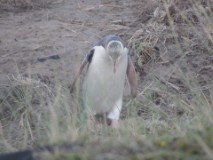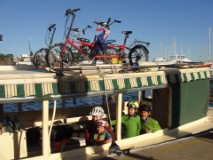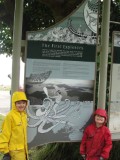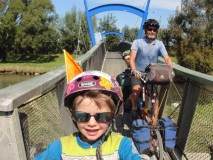It’s pure peace.
Like I’m living inside a meditation tape, I hear only the soothing waves of the sea. Open my eyes and I’m still there – perched on a driftwood log, watching the tide slide out of Tasman Bay on New Zealand’s South Island. To the right, the last sliver of sun clings to the mountains we conquered a few days ago, en route from the mountain biking paradise of the Marlborough Sounds. To the left, the vast, rocky wilderness of Abel Tasman National Park – tomorrow’s quest – stretches northward into the water. Down the middle, a 75-km-wide horizon ebbs and flows at its own lazy pace into the open ocean.
I’m on Kina Beach, in a perfect spot I may never see again. Before me are the ruins where briefly stood an ingenious stic k fort that our sons, aged 8 and 6, constructed as a fleeting testament to our presence. Our family tandem bicycles – one parent and one kid on each – are parked next to our tent just ten metres behind me, resting for our next expedition. We’ve claimed this space for tonight, and in the morning we’ll leave it for someone else to discover. We’re modern explorers, without the colonialism… or (thanks to Joce’s veggie obsession) the scurvy.
Like Columbus and Cartier, we thrive on discovery. Every day on our bike tour across New Zealand and Australia is entirely different – an exhilarating and endless cycle of new scenery, experiences and friendships. The maps we pored over for months before this six-month family Oceania Odyssey come instantly alive with our newfound familiarity and a lifetime of memories.
In New Zealand we visited Ship’s Cov e, where Captain James Cook first set a European boot on what the Maori had been calling Te Aotearoa for 500 years (since the legendary traveller Kupe actually discovered the place). Too bad Cook didn’t bring his bicycle – he could have seen much more of this remarkable land.
e, where Captain James Cook first set a European boot on what the Maori had been calling Te Aotearoa for 500 years (since the legendary traveller Kupe actually discovered the place). Too bad Cook didn’t bring his bicycle – he could have seen much more of this remarkable land.
 e, where Captain James Cook first set a European boot on what the Maori had been calling Te Aotearoa for 500 years (since the legendary traveller Kupe actually discovered the place). Too bad Cook didn’t bring his bicycle – he could have seen much more of this remarkable land.
e, where Captain James Cook first set a European boot on what the Maori had been calling Te Aotearoa for 500 years (since the legendary traveller Kupe actually discovered the place). Too bad Cook didn’t bring his bicycle – he could have seen much more of this remarkable land.Exploring new countries on two wheels is pure magic. Instead of taking hundred-dollar tours to see wildlife, we glimpse it from our backroad-and-cycletrail perches: the elusive white heron spearing fish on west coast glacier rivers; endangered yellow-eyed penguins from a grass-covered hide as they emerge from their feast at sea to return to their nests; and kangaroos nibbling breakfast in the bush camp site we reached by an old fire track.
Our greatest discoveries have been found through the advice of locals we meet along the way, who are intrigued by our bike set-up and strike up conversation. In a campervan we would have flown right past Nikau Caves, on a dirt road well outside Auckland, en route to the glitzier Waitomo. But a woman we met camping in Shekinah – also way off the main path – tipped us to this rugged tour (given just for us by the farmer whose land the caves are beneath) squeezing through crevices and wading knee-deep through underground lakes to the cavern lair of thousands of glow worms.
One night, a month later, we stopped at Curio Bay where we heard that dolphins come close to shore on rare occasion. We arrived just before sunset (happily now at about 5pm, so the boys don’t have to stay up late to catch all the dusk-time animal viewing) and saw nothing for a half-hour. Then Sitka and Heron started dancing and singing for the dolphins to come out and play. “That’s cute,” thought Ed, not believing two bouncing boys could sumon wild sea mammals with song – until a dozen or more Hector’s dolphins popped out of nowhere, not 15 metres off the beach, and began surfing the waves as they crashed on the shore. They put on an hour-long show better than any aquarium stage, leaping and spinning about, as Heron and Sitka put on a show for them too, screeching and leaping in the air every time the dolphins surfaced.
More often than not we’re the only human presence on a trail, campsite or back road – alone with the sounds of conversing tui birds or guffawing cockatoos. Maybe, we think, like our European ancestors, we should plant our family flag in these spots and name them after family members, as though the footprints under the dirt never existed.
Heron Hill.
Sitka Stream.
Daddy Island.
Mommyville.
We’ve felt the exhilarating thrill of a successful expedition each afternoon when we discover our destination – and on that sunny day at Bluff when our tires reached the southernmost tip of New Zealand, 3,400km from when we left Cape Reinga at the northernmost point.
“We did it!” cried the boys. “What’s next?”
Each night we look up at the stars (now appearing by 5:30pm as the southern winter approaches) outside our small nylon home, breathe deeply and wonder about who else is out there looking back at us. Tomorrow we’ll find new lands beneath our bike tires and new worlds all around us. We’ll go places we’ve never been, and see things we may never see again.
Then we’ll stop for frisbee and ice cream, and leave those places for the next explorer family.
Take that, Captain Cook.




